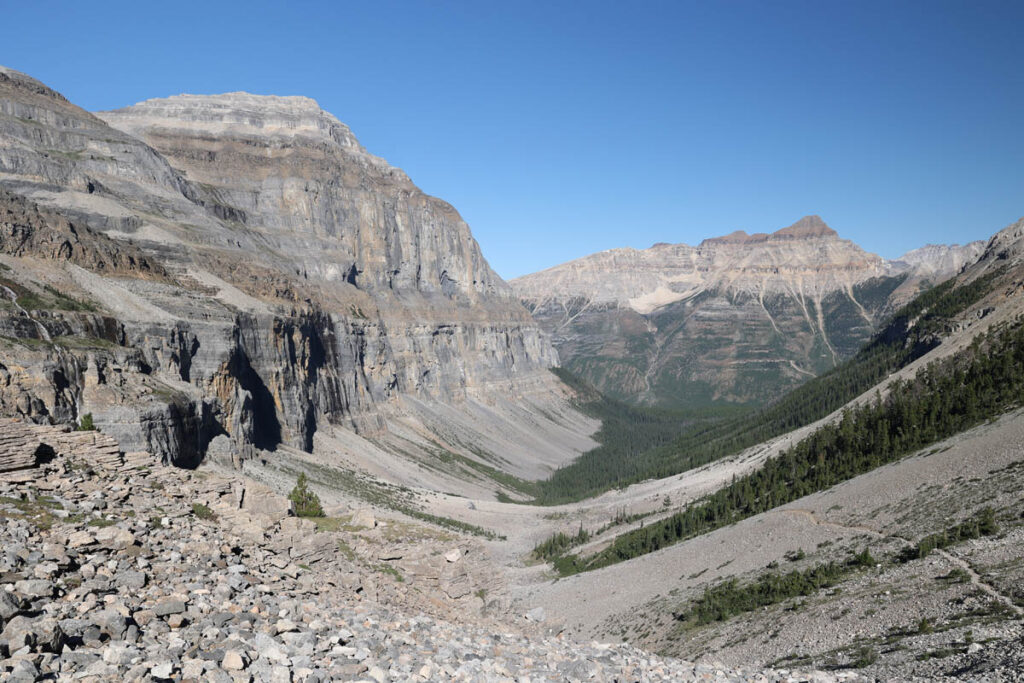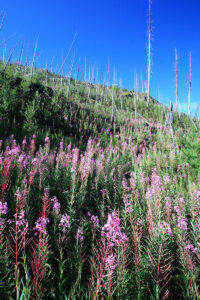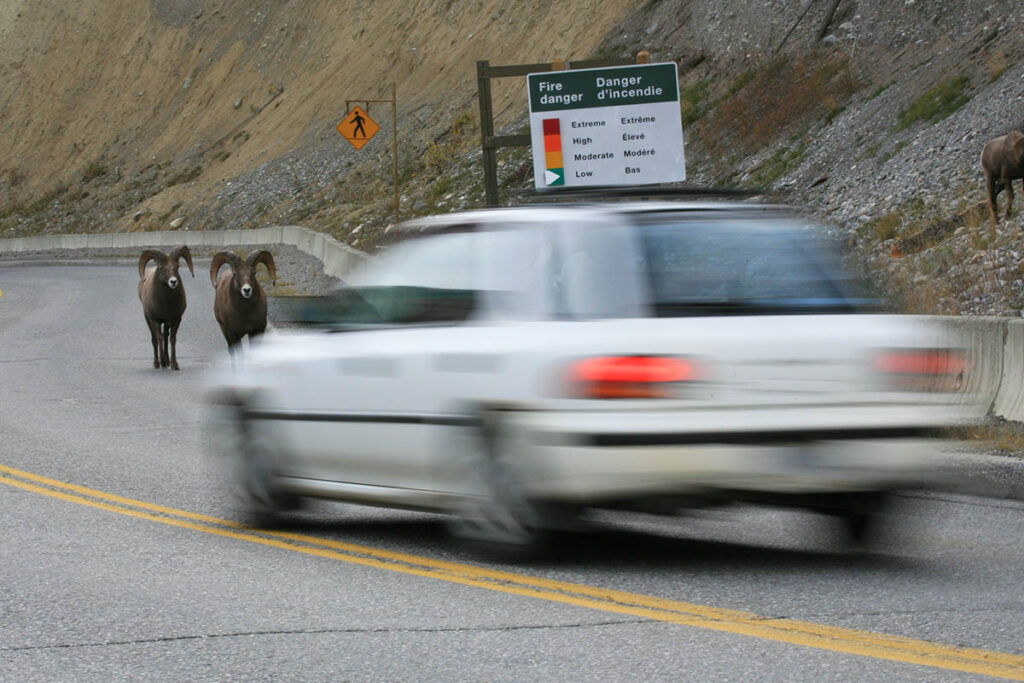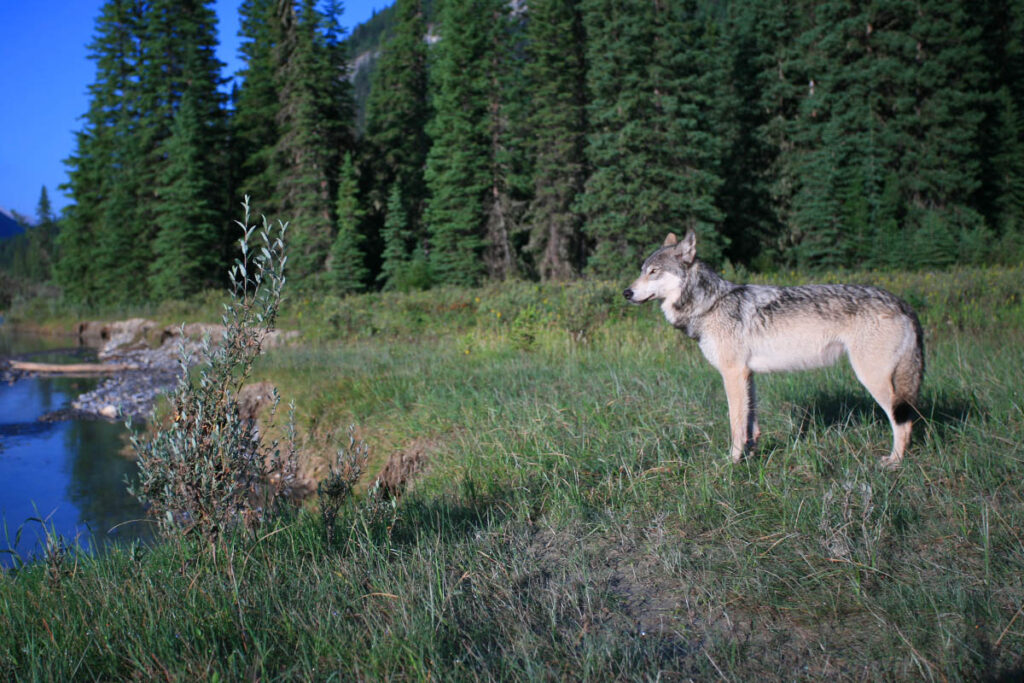Kootenay National Park Nature Guide
The Kootenay National Park Nature Guide describes the geology, plants, and animals of Kootenay National Park in the Canadian Rockies.
Kootenay National Park lies on the western side of the Continental Divide, straddling the Main and Western ranges of the Canadian Rockies. As elsewhere in the Canadian Rockies, the geology of Kootenay National Park is complex. Over the last 70 million years, these mountains have been pushed upward—folded and faulted along the way—by massive forces deep beneath the earth’s surface. They’ve also been subject to erosion that entire time, particularly during the ice ages, when glaciers carved U-shaped valleys and high cirques into the landscape. These features, along with glacial lakes and the remnants of the glaciers themselves, are readily visible in Kootenay National Park today. The park protects the upper headwaters of the Vermilion and Kootenay Rivers, which drain into the Columbia River south of Kootenay National Park.

A classic U-shaped valley in Kootenay National Park.
Kootenay National Park Trees, Plants, and Flowers

Fireweed is common in burnt areas.
If you drive through Kootenay National Park in August, it’s impossible to miss bright pink fireweed, which carpets entire mountainsides that have been affected by wildfire.
In the lowest areas of Kootenay National Park, in the Kootenay River Valley, Douglas fir and lodgepole pine find a home. Along the upper stretches of the Vermilion River Valley, where the elevation is higher, Engelmann spruce thrive, while immediately above lie forests of subalpine fir. The tree line in Kootenay National Park is at around 2,000 metres (6,560 feet) above sea level. This is the alpine, where low-growing species such as willow and heather predominate. For a short period each summer, these elevations come alive with colour as forget-me-nots, avens, and avalanche lilies flower.
Of special interest is the Simpson River interpretive trail through an area where fire destroyed thousands of hectares of forest in 2018. This area is an excellent place to see the natural regeneration process at work.
Kootenay National Park Wildlife
While Kootenay National Park provides ample opportunities for seeing numerous animals in their natural habitat, it also leads to human-animal encounters that are not always positive, especially along the Highway 93 corridor. Please drive slowly in Kootenay National Park.
For the best places to see wildlife, go to our Kootenay National Park Wildlife Viewing page.

Drive carefully to avoid wildlife that is often seen on roadways.
Mule Deer and White-Tailed Deer
Mule deer and white-tailed deer are similar in size and appearance. Their colour varies with the season but is generally light brown in summer, turning dirty gray in winter. While both species are considerably smaller than elk, the mule deer is a little stockier than the white-tailed deer. The mule deer has a white rump, a white tail with a dark tip, and large mulelike ears. It inhabits open forests along valley floors. The white-tailed deer’s tail is dark on top, but when the animal runs, it holds its tail erect, revealing an all-white underside. Whitetails frequent thickets along the rivers and lakes of the foothills. They are most commonly along Highway 93 at dawn and dusk.
Elk
The elk, or wapiti, is the most widespread and common of the larger mammals living in the Canadian Rockies, but is not particularly common in Kootenay National Park. It has a tan body with a dark-brown neck, dark-brown legs, and a white rump. This second-largest member of the deer family weighs 250-450 kilograms (550-1,000 pounds) and stands 1.5 metres (five feet) at the shoulder. Beginning each spring, bulls grow an impressive set of antlers, covered in what is known as velvet. The velvet contains nutrients that stimulate antler growth. By fall, the antlers have reached their full size and the velvet is shed. Rutting season takes place between August and October; listen for the shrill bugles of the bulls serenading the females. During the rut, randy males will challenge anything with their antlers and can be dangerous. The bulls shed their antlers each spring, but don’t relax too much because, also in spring, females protecting their young can be equally dangerous.
Moose
The giant of the deer family is the moose, an awkward-looking mammal that appears to have been designed by a cartoonist. It has the largest antlers of any animal in the world, stands up to 1.8 metres (six feet) at the shoulder, and weighs up to 500 kilograms (1,100 pounds). Its body is dark brown, and it has a prominent nose, long spindly legs, small eyes, big ears, and an odd flap of skin called a bell dangling beneath its chin. Apart from all that, it’s good-looking. Each spring, the bull begins to grow palm-shaped antlers that by August will be fully grown. Moose are solitary animals preferring marshy areas and weedy lakes, but they are known to wander to higher elevations searching out open spaces in summer. They forage in and around ponds on willows, aspens, birches, grasses, and all aquatic vegetation. They are not particularly common in Kootenay National Park, but we have seen them in habitat as varied as regenerating forest near Maligne Canyon and in the montane forest along Settlers Road. Although they may appear docile, moose will attack humans if they feel threatened.
Bears
The two species of bears present in Kootenay National Park—BLACK BEARS and GRIZZLIES—can be differentiated by size and shape. Grizzlies are larger than black bears and have a flatter, dish-shaped face and a distinctive hump of muscle behind their neck. Colour is not a reliable way to tell them apart. Black bears are not always black. They can be brown or cinnamon, causing them to be confused with the brown-coloured grizzly.
Black bears are widespread throughout all forested areas of Kootenay National Park, and are also common along Highway 93 in spring, especially near Olive Lake where a NO Stopping zone is put in place to protect the safety of both black and grizzly bears. Their weight varies considerably, but males average 150 kilograms (330 pounds) and females 100 kilograms (220 pounds). Their diet is omnivorous, consisting primarily of grasses and berries but supplemented by small mammals. They are not true hibernators, but in winter they can sleep for up to a month at a time before changing position. During this time, their heartbeat drops to 10 beats per minute, their body temperature drops, and they lose up to 30 percent of their body weight. Females reach reproductive maturity after five years; cubs, usually two, are born in late winter, while the mother is still asleep.
Grizzlies, second largest of eight recognized species of bears worldwide (only polar bears are larger), have disappeared from most of North America but are widespread throughout the Canadian Rockies and Kootenay National Park, numbering around 100 in the region. Grizzlies are only occasionally seen by casual observers; most sightings occur in alpine and subalpine zones, although sightings at lower elevations are not unusual, especially when snow falls early or late. The bears’ colour ranges from light brown to almost black, with dark tan being the most common. On average, males weigh 200-350 kilograms (440-770 pounds). The bears eat small and medium-size mammals, and berries in fall. Like black bears, they sleep through most of the winter. When they emerge in early spring, the bears scavenge carcasses of animals that succumbed to the winter, until the new spring vegetation becomes sufficiently plentiful. Females first give birth at four years old, and then every three years, with cubs remaining with their mother for 2-3 years.
Coyotes
The coyote is often mistaken for a wolf when in fact it is much smaller, weighing up to only 15 kilograms (33 pounds). It has a pointed nose and a long, bushy tail. Its colouring is a mottled mix of brown and gray, with lighter-coloured legs and belly. The coyote is a skillful and crafty hunter, preying mainly on rodents. Coyotes have the remarkable ability to hear the movement of small mammals under the snow, allowing them to hunt these animals without actually seeing them. Coyotes are widespread along the lower sections of Highway 93. They are attracted to cleared areas of valley bottoms by an abundance of small game, and many have permanent dens there. They are often seen patrolling the edges of highways and crossing open meadows in low-lying valleys.
Wolves
Although no wolf packs call Kootenay National Park home, lone wolves are occasionally spotted along Highway 93 between Kootenay and Vermilion Crossings.
Wolves that inhabit the region are larger than coyotes and larger than the wolves of eastern Canada. They weigh up to 60 kilograms (132 pounds), stand up to one metre (3.2 feet) high at the shoulder, and resemble large huskies or German shepherds. Their colour ranges from snow white to brown or black; those in the Canadian Rockies are, most often, shades of gray. They usually form packs of up to eight members, travelling, hunting, and resting together, and adhering to a hierarchical social order. As individuals, they are complex and intriguing, capable of expressing happiness, humor, and loneliness.

A wolf beside the Vermilion River.
Cougars
Rarely encountered by casual hikers, these majestic creatures (known in other parts of North America as mountain lions, pumas, or catamounts) measure up to 1.5 metres (five feet) long. The average male weighs 75 kilograms (165 pounds) and the female 40-55 kilograms (90-120 pounds). Cougars are versatile hunters whose acute vision takes in a peripheral span in excess of 200 degrees. They typically kill a large mammal such as an elk or deer every 12-14 days, eating part of it and caching the rest. Their diet also includes chipmunks, ground squirrels, snowshoe hares, and occasionally porcupines. Their athletic prowess puts Olympians to shame. They can spring forward more than 8 metres (26 feet) from a standstill, leap 4 metres (13 feet) into the air, and safely jump from a height of 20 metres (65 feet).
The cougar is a solitary animal with distinct territorial boundaries. This limits its population density, which in turn means that its overall numbers are low. They are most common in the south of Kootenay National Park around Sinclair Canyon, where they hunt bighorn sheep.
Lynx
The elusive lynx is identifiable by its pointy black ear tufts and an oversized tabby cat appearance. The animal has broad, padded paws that distribute its weight, allowing it to float on the surface of snow. It weighs up to 10 kilograms (22 pounds) but appears much larger because of its coat of long, thick fur. The lynx, uncommon but widespread throughout the region, is a solitary creature that prefers the cover of subalpine forests, feeding mostly at night on snowshoe hares and other small mammals. Although present, lynx are rarely seen in Kootenay National Park and when there are reports it’s generally fleeting glimpses in winter.
Mountain Goats
The most common large mammal present in Kootenay National Park is the mountain goat, but these flighty creatures stay at high elevations, feeding in alpine meadows throughout summer. The remarkable rock-climbing ability of these nimble-footed creatures allows them to live on rocky ledges or near-vertical slopes, safe from predators. The goats stand one metre (3.2 feet) at the shoulder and weigh 65-130 kilograms (140-290 pounds). Both sexes possess a peculiar beard, or rather, goatee. Both sexes have horns. It is possible to determine the sex by the shape of the horns; those of the female grow straight up before curling slightly backward, whereas those of the male curl back in a single arch. The goats shed their thick coats each summer, making them look ragged, but by fall they’ve regrown a fine, new white woolen coat.
Bighorn Sheep
Bighorn sheep are some of the most distinctive mammals of Kootenay National Park. Easily recognized by their impressive horns, they are often seen grazing on grassy mountain slopes or at salt licks beside the road. The colour of their coat varies with the season; in summer, it’s a brownish-gray with a cream-coloured belly and rump, turning lighter in winter. Fully grown males can weigh up to 120 kilograms (270 pounds), while females generally weigh around 80 kilograms (180 pounds). Both sexes possess horns, rather than antlers like members of the deer family. Unlike antlers, horns are not shed each year and can grow to astounding sizes. The horns of rams are larger than those of ewes and curve up to 360 degrees. The spiraled horns of an older ram can measure longer than one metre (3.2 feet) and weigh as much as 15 kilograms (33 pounds). During the fall mating season, a hierarchy is established among the rams for the right to breed ewes. As the males face off against each other to establish dominance, their horns act as both a weapon and a buffer against the head butting of other rams. The skull structure of the bighorn, rams in particular, has become adapted to these head-butting clashes, keeping the animals from being knocked unconscious. Your best chance of seeing one of Kootenay National Park’s bighorn is near the south entrance, as well as just outside the park in and around the town of Radium Hot Springs.
Bighorn sheep are particularly tolerant of humans and often approach parked vehicles; although they are not especially dangerous, as with all mammals, you should not approach or feed them.
Squirrels
Several species of squirrels are common in Kootenay National Park. The GOLDEN-MANTLED GROUND SQUIRREL, found in rocky outcrops of subalpine and alpine regions, has black stripes along its sides and looks like an oversized chipmunk. Most common is the COLUMBIAN GROUND SQUIRREL, which lives in burrows, often in open grassland. It is recognizable by its reddish legs, face, and underside, and a flecked, grayish back. The bushy-tailed RED SQUIRREL, the bold chatterbox of the forest, leaves telltale shelled cones at the base of conifers.
Hoary Marmots
High in the mountains, above the tree line, hoary marmots are often seen sunning themselves on boulders in rocky areas or meadows. They are stocky creatures, weighing 4-9 kilograms (9-19 pounds). When danger approaches, these large rodents emit a shrill whistle to warn their colony. Marmots are active only for a few months each summer, spending up to nine months a year in hibernation. Seeing marmots in their natural Kootenay National Park habitat requires more hiking than elsewhere in the Canadian Rockies. Easiest to reach is the plateau at the back of the Stanley Glacier Trail, while further out search them out along the Rockwall and Kindersley Pass Trails. See Kootenay National Park Hiking for details.
Porcupines
This small, squat animal is easily recognized by its thick coat of quills. It eats roots and leaves but is also known as being destructive around wooden buildings and vehicle tires. Porcupines are common and widespread throughout all forested areas, but they’re hard to spy because they feed most often at night. Porcupines are relatively rare in Kootenay National Park, but you may see them scurrying off the trail on an early morning hike through subalpine forest.
Shrews
A member of the insectivore family, the furry shrew has a sharp-pointed snout and is closely related to the mole. It must eat almost constantly because it is susceptible to starvation within only a few hours of its last meal. Another variety present throughout the region, the pygmy shrew is the world’s smallest mammal; it weighs just four grams (0.1 ounce).
Pikas
Pikas, like rabbits, are lagomorphs, which are distinguished from rodents by a double set of incisors in the upper jaw. The small, grayish pika is a neighbor to the marmot, living among the rubble and boulders of scree slopes above timberline.
Weasels
The weasel family, comprising 70 species worldwide, is large and diverse, but in general, all members have long, slim bodies and short legs, and all are carnivorous and voracious eaters, consuming up to one-third of their body weight each day. Many species can be found in the Canadian Rockies, including the WOLVERINE, largest of the weasels worldwide, weighing up to 20 kilograms (44 pounds). Known to indigenous peoples as carcajou (evil one), the wolverine is extremely powerful, cunning, and cautious. This solitary creature inhabits forests of the subalpine and lower alpine regions, feeding on any available meat, from small rodents to the carcasses of larger mammals. Occasionally sighted by hikers in the remote northwest of Kootenay National Park, the wolverine is a true symbol of the wilderness.
The FISHER has the same habitat as the wolverine but is much smaller, reaching just five kilograms (11 pounds) in weight and growing up to 60 centimetres (24 inches) in length. This nocturnal hunter preys on small birds and rodents, but reports of fishers bringing down small deer have been made. Smaller still is the MARTEN, which lives most of its life in the trees of the subalpine forest, preying on birds, squirrels, mice, and voles.
As well as being home to the largest member of the weasel family, the region also holds the smallest—the LEAST WEASEL (the world’s smallest carnivore), which grows to a length of just 20 centimetres (8 inches) and weighs a maximum of 60 grams (2 ounces). Chiefly nocturnal, it feeds mostly on mice and lives throughout open wooded areas, but it is not particularly common.
Birds
Birdwatching is popular in Kootenay National Park, thanks to the approximately 180 resident bird species and the hundreds of thousands of migratory birds that pass through each fall. All it takes is a pair of binoculars, a good book detailing species, and patience. Dense forests hide many species, making them seem less common than they are. The
Raptors
GOLDEN EAGLES migrate across Kootenay National Park, heading north in spring to Alaska and crossing back over in fall en route to Midwest wintering grounds. Golden eagles—more than 10,000 of them annually—soar high above the mountains on thermal drafts. BALD EAGLES also soar over the Canadian Rockies during annual migrations; mature birds can be distinguished from below by their white head and tail (immature birds resemble the dark-brown-coloured golden eagle).
OSPREYS spend summers in the region, nesting high up in large dead trees, on telephone poles, or on rocky outcrops, but always overlooking water; look for their nests along the Kootenay River. They feed on fish, hovering up to 50 metres (160 feet) above water, watching for movement, then diving into the water, thrusting their legs forward and collecting prey in their talons.
Distinct from all previously listed species is a group of raptors that hunt at night. Best known as owls, these birds are rarely seen because of their nocturnal habits but are widespread throughout forested areas of the mountains. Most common is the GREAT HORNED OWL, identified by its prominent “horns,” which are actually tufts of feathers.
Other Birds
Widespread within Kootenay National Park are MAGPIES, SPARROWS, STARLINGS, GROUSE, RAVENS, and CROWS. BLACKBIRDS, FINCHES, THRUSHES, HUMMINGBIRDS, WOODPECKERS, FLYCATCHERS, and 28 species of WARBLERS are common in forested areas. PTARMIGAN are common in open meadows above the tree line. A popular campground visitor, the cheeky GRAY JAY is similar in appearance to the curious CLARK’S NUTCRACKER.
